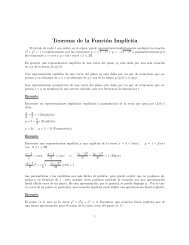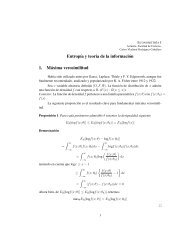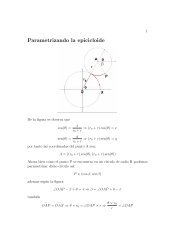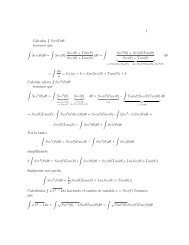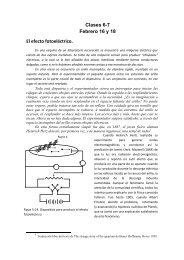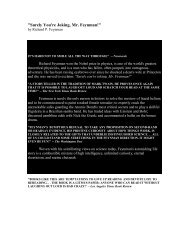Regla de la Cadena
Regla de la Cadena
Regla de la Cadena
Create successful ePaper yourself
Turn your PDF publications into a flip-book with our unique Google optimized e-Paper software.
<strong>Reg<strong>la</strong></strong> <strong>de</strong> <strong>la</strong> Ca<strong>de</strong>na<br />
Teorema: Si f : R3 → R es diferenciable, entonces todas <strong>la</strong>s <strong>de</strong>rivadas direccionales existen. La<br />
<strong>de</strong>rivada direccional en x en <strong>la</strong> dirección v está dada por<br />
<br />
∂f<br />
Dfv(x) = gradf(x) · v = ∇f(x) · v =<br />
∂x (x)<br />
<br />
∂f<br />
v1 +<br />
∂y (x)<br />
<br />
∂f<br />
v2 +<br />
∂z (x)<br />
<br />
v3<br />
Dem: Sea c(t) = x + tv <strong>de</strong> manera f(x + tv) = f(c(t)) aplicando el caso particu<strong>la</strong>r <strong>de</strong> <strong>la</strong> reg<strong>la</strong> <strong>de</strong> <strong>la</strong> ca<strong>de</strong>na<br />
df(c(t))<br />
= ∇f(c(t)) · d(t)<br />
dt<br />
por otro <strong>la</strong>do c(0) = f(x), c ′ (t) = v por lo tanto c ′ (0) = v, así que<br />
Dfv(x) =<br />
df(x + tv)<br />
dt<br />
<br />
<br />
<br />
t=0<br />
= ∇f(x) · v<br />
Ejemplo: Sean f(x, y, z) = z 2 e −yz . Calcu<strong>la</strong>r <strong>la</strong> razón <strong>de</strong> cambio <strong>de</strong> f en <strong>la</strong> dirección <strong>de</strong>l vector unitario<br />
v = ( 1 √ 3 , 1 √ 3 , 1 √ 3 ) en (1, 0, 0)<br />
Solución:<br />
∇f · v = (2xe −yz , −zx 2 e −yz , −yx 2 e −yz ) (1,0,0) · ( 1 √ 3 , 1 √ 3 , 1 √ 3 ) = (2, 0, 0)( 1 √ 3 , 1 √ 3 , 1 √ 3 ) = 2 √ 3<br />
Teorema: Supongamos que ▽f(x) = 0. Entonces ∇f(x) apunta en <strong>la</strong> dirección a lo <strong>la</strong>rgo <strong>de</strong> <strong>la</strong> cual f<br />
crece mas rapido.<br />
Dem: Si v es un vector unitario, <strong>la</strong> razón <strong>de</strong> cambio <strong>de</strong> f en <strong>la</strong> direccón <strong>de</strong> v esta dada por ∇f(x) · v y<br />
∇f(x) · v = ∇f(x)vCosθ = ∇f(x)Cosθ don<strong>de</strong> θ es el ángulo entre ∇f, v. Esta es máximo cuando<br />
θ = 0 y esto ocurre cuando v, ∇f son paralelos. En otras pa<strong>la</strong>bras , si queremos movernos en una direcciön<br />
en <strong>la</strong> cual f va a crecer más rapidamente, <strong>de</strong>bemos proce<strong>de</strong>r en <strong>la</strong> direcciön en <strong>la</strong> cual f <strong>de</strong>crece más<br />
rapido, habemos <strong>de</strong> proce<strong>de</strong>r en <strong>la</strong> dirección ∇f.<br />
Caso particu<strong>la</strong>r <strong>de</strong> <strong>la</strong> reg<strong>la</strong> <strong>de</strong> <strong>la</strong> ca<strong>de</strong>na<br />
Supongamos que C : R → R 2 es una trayectoria diferenciable y f : R → R. Sea h(t) = f(c(t)) =<br />
f(x(t), y(t), z(t)) don<strong>de</strong> c(t) = (x(t), y(t), z(t)). Entonces<br />
Esto es ∂h<br />
∂h<br />
∂t<br />
∂f ∂x ∂f ∂y ∂f ∂z<br />
= + +<br />
∂x ∂t ∂y ∂t ∂z ∂t<br />
∂t = ∇f(c(t)) · c′ (t) don<strong>de</strong> c ′ (t) = (x ′ (t), y ′ (t), z ′ (t))<br />
Dem: Por <strong>de</strong>finición dh<br />
dt (t0)<br />
h(t) − h(t0)<br />
h(t) − h(t0)<br />
= lím<br />
sumando y restando =<br />
t→0 t − t0<br />
t − t0<br />
f(c(t)) − f(c(t0))<br />
=<br />
t − t0<br />
f(x(t), y(t), z(t)) − f(x(t0), y(t0), z(t0))<br />
=<br />
t − t0<br />
f(x(t), y(t), z(t))<br />
t − t0<br />
+ −f(x(t0), y(t), z(t)) + f(x(t0), y(t), z(t)) − f(x(t0), y(t0), z(t)) + f(x(t0)), y(t0), z((t)) − f(x(t0), y(t0), z(t0))<br />
t − t0<br />
1<br />
(∗)
Aplicando el T.V.M.<br />
f(x(t), y(t), z(t)) − f(x(t0), y(t), z(t)) = ∂f<br />
(c, y(t), z(t))(x(t) − x(t0))<br />
∂x<br />
f(x(t0), y(t), z(t)) − f(x(t0), y(t0), z(t)) = ∂f<br />
(x(t), d, z(t)(y(t) − y(t0))<br />
∂y<br />
f(x(t0), y(t0), z(t)) − f(x(t0), y(t0), z(t0)) = ∂f<br />
(x(t), y(t), e)(z(t) − z(t0))<br />
∂y<br />
∴ ∗ = ∂f<br />
∂f<br />
∂f<br />
(c, y(t), z(t))(x(t)−x(t0))+ (x(t), d, z(t))(y(t)−y(t0))+<br />
∂x ∂y ∂z (x(t), y(t), e)(z(t)−z(t0)) tomando<br />
lím t → t0 y por <strong>la</strong> continuidad <strong>de</strong> <strong>la</strong>s parciales<br />
∂h<br />
∂t<br />
∂f ∂x ∂f ∂y ∂f ∂z<br />
= + +<br />
∂x ∂t ∂y ∂t ∂z ∂t<br />
Ejemplo: Verificar <strong>la</strong> reg<strong>la</strong> <strong>de</strong> <strong>la</strong> ca<strong>de</strong>na para f(u, v, w) = u2 +v2−w don<strong>de</strong> u(x, y, z) = x2y, v(x, y, z) =<br />
y2 , w(x, y, z) = e−xz así ∂f ∂u ∂f ∂v ∂f ∂w<br />
+ +<br />
∂u ∂x ∂v ∂x ∂w ∂x = 2x2y(2xy) + ze −xy<br />
n<br />
1=1<br />
Ejemplo:¿En que dirección <strong>de</strong>s<strong>de</strong> (0, 1) crece mas rapido f(x, y) = x2 − y2 ?<br />
Sol: El gradiente es ∇f = (2x, −2y) (0,1) = (0, 2)<br />
2
Ahora cuando hab<strong>la</strong>mos <strong>de</strong> los conjuntos <strong>de</strong> nivel f(x, y = k), si tenemos que c(t)ɛf<br />
f(c(t)) = K ∴ f ′ (c(t)) = 0<br />
∴ ∇f(c(0)) · v = 0<br />
Si v es un vector tangente t=0 entonces<br />
∇f es ortogonal a los conjuntos <strong>de</strong> nivel<br />
El gradiente es normal a <strong>la</strong>s superficies <strong>de</strong> nivel. Sea f : R 3 → R una aplicación C 1 y sea (x0, y0, z0) un<br />
punto sobre <strong>la</strong> superficie <strong>de</strong> nivel S <strong>de</strong>finida por f(x, y, z) = k, k = cte. Entonces ∇f(x0, y0, z0) Es normal<br />
a <strong>la</strong> superficie <strong>de</strong> enivel en el siguiente sentido: si v es el vector tangente en t = 0 <strong>de</strong> una trayectoria c(t)<br />
con c(0) = (x0, y0, z0) entonces ∇f · v = 0.<br />
Dem: Sea c(f) en S, entonces f(c(t)) = K.<br />
Sea v como en <strong>la</strong> hipotesis entonces<br />
v = c ′ (0) ∴ 0 = d<br />
dt f(c′ <br />
<br />
(t)) ∇f(c(0)) · v<br />
3<br />
t=0
Caso particu<strong>la</strong>r <strong>de</strong> <strong>la</strong> reg<strong>la</strong> <strong>de</strong> <strong>la</strong> ca<strong>de</strong>na<br />
Supongamos que C : R → R 3 es una trayectoria diferencias y f : R 3 → R. Sea h(t) = f(c(t)) =<br />
f(x(t), y(t), z(t)) don<strong>de</strong> c(t) = x(t), y(t), z(t). Entonces<br />
∂h<br />
∂t<br />
∂f ∂x ∂f ∂y ∂f ∂z<br />
= + +<br />
∂x ∂t ∂y ∂t ∂z ∂t<br />
Esto es ∂h<br />
∂t = ∇f(c(t)) · c′ (t) don<strong>de</strong> c ′ (t) = (x ′ (t), y ′ (t), z ′ (t))<br />
Demostración: Por <strong>de</strong>finición ∂h<br />
∂t (t0) = lím<br />
t→0<br />
h(t) − h(t0)<br />
t − t0<br />
= f(c(t)) − f(c(t0))<br />
t − t0<br />
h(t) − h(t0)<br />
t − t0<br />
= f(x(t), y(t), z(t)) − f(x(t0), y(t0), z(t0))<br />
t − t0<br />
=<br />
sumando y restando<br />
f(x(t), y(t), z(t)) − f(x(t0), y(t), z(t)) + f(x(t0), y(t), z(t))<br />
−f(x(t0), y(t0), z(t)) + f(x(t0), y(t0), z(t)) − f(x(t0), y(t0), z(t0))<br />
Aplicando el Teorema <strong>de</strong>l Valor Medio<br />
t − t0<br />
f(x(t), y(t), z(t)) − f(x(t0), y(t), z(t)) = ∂f<br />
(c, y(t), z(t))(x(t) − x(t0))<br />
∂x<br />
f(x(t0), y(t), z(t)) − f(x(t0), y(t0), z(t)) = ∂f<br />
(x(t), d, z(t))(y(t) − y(t0))<br />
∂y<br />
f(x(t0), y(t0), z(t)) − f(x(t0), y(t0), z(t0)) = ∂f<br />
(x(t), y(t), e)(z(t) − z(t0))<br />
∂z<br />
∴ (∗) =<br />
∂f<br />
(x(t)−y(t))<br />
(c, y(t), z(t)) ∂x t−t0<br />
+<br />
∂f<br />
(y(t)−y(t0))<br />
(x(t), d, z(t)) ∂y t−t0<br />
+<br />
∂f<br />
(z(t)−z(t0))<br />
(x(t), y(t), e) ∂z t−t0<br />
tomando el lím y por <strong>la</strong> continuidad <strong>de</strong> <strong>la</strong>s parciales<br />
t→t0<br />
∂h<br />
∂t<br />
∂f ∂x ∂f ∂y ∂f ∂z<br />
= + +<br />
∂x ∂t ∂y ∂t ∂z ∂t<br />
1<br />
. . . (∗)
Ejemplo: Verificar <strong>la</strong> reg<strong>la</strong> <strong>de</strong> <strong>la</strong> ca<strong>de</strong>na para f(u, v, w) = u 2 + v 2 − w don<strong>de</strong> u(x, y, z) =<br />
x 2 y, v(x, y, z) = y 2 , w(x, y, z) = e −xz asi<br />
∂f ∂u ∂f ∂v ∂f ∂w<br />
+ +<br />
∂u ∂x ∂v ∂x ∂w ∂x = 2x2y(2xy) + ze −xz<br />
Teorema: Si f : R 3 → R es diferenciable, entonces todas <strong>la</strong>s <strong>de</strong>rivadas direccionales existen.<br />
La <strong>de</strong>rivada<br />
<br />
direccional en x en <strong>la</strong> dirección v esta dada por Dfv(x) = gradf(x) · v =<br />
∂f<br />
∇f(x) · v =<br />
∂x (x)<br />
<br />
∂f<br />
v1 +<br />
∂y (x)<br />
<br />
∂f<br />
v2 +<br />
∂z (x)<br />
<br />
v3<br />
Demostración: Sea c(t) = x + tv <strong>de</strong> manera f(x + tv) = f(c(t)) aplicando el caso<br />
particu<strong>la</strong>r <strong>de</strong> <strong>la</strong> reg<strong>la</strong> <strong>de</strong> <strong>la</strong> ca<strong>de</strong>na df(c(t))<br />
= ∇f(c(t)) · d(t)<br />
dt<br />
por otro <strong>la</strong>do c(0) = f(x), c ′ (t) = v ∴ c ′ (0) = v asi que<br />
<br />
df(x + tv <br />
Dfv(x) = <br />
dt<br />
= ∇f(x) · v<br />
Ejemplo: Sean f(x, y, z) = z2e−yz . Calcu<strong>la</strong>r <strong>la</strong> razón <strong>de</strong> cambio <strong>de</strong> f en <strong>la</strong> dirección <strong>de</strong>l vector<br />
<br />
1<br />
unitario v = √3 , 1 √ ,<br />
3 1<br />
<br />
√ en (1,0,0)<br />
3<br />
Solución :<br />
t=0<br />
∇f · v = (2xe −yz , −zx 2 e −yz , −yx 2 e −yz ) (1,0,0) ·<br />
= (2, 0, 0)<br />
= 2<br />
√ 3<br />
<br />
√3 1 , 1 √ ,<br />
3 1<br />
<br />
√<br />
3<br />
<br />
√3 1 , 1 √ ,<br />
3 1<br />
<br />
√<br />
3<br />
Teorema: ‘Supongamos que ∇f(x) = 0. Entonces ∇f(x) apunta en <strong>la</strong> dirección a lo <strong>la</strong>rgo <strong>de</strong><br />
<strong>la</strong> cual f crece mas rapido.<br />
Demostración: Si v es una recta unitaria, <strong>la</strong> razón <strong>de</strong> cambio <strong>de</strong> f en <strong>la</strong> dirección v esta<br />
dada por ∇f(x) · v y ∇f(x) · v = ∇f(x)v cos θ = ∇f(x) cos θ don<strong>de</strong> θ es el<br />
ángulo entre ∇f(x), v. Este es máximo cuando θ = 0 y esto ocurre cuando v, ∇f(x),<br />
son paralelos. En otras pa<strong>la</strong>bras, si queremos movernos en una dirección en <strong>la</strong> cual f<br />
va a crecer más rapidamente, <strong>de</strong>bemos proce<strong>de</strong>r en <strong>la</strong> dirección en <strong>la</strong> cual f <strong>de</strong>crece<br />
más rápido, habremos <strong>de</strong> proce<strong>de</strong>r en <strong>la</strong> dirección −∇f(x).<br />
2
Ejemplo: ¿En que dirección <strong>de</strong>s<strong>de</strong> (0, 1) crece más rápido f(x, y) = x 2 − y 2 ?<br />
Solución: El gradiente es ∇f = (2x, −2y)(0,1) = (0, −2)<br />
Ahora cuando hab<strong>la</strong>mos <strong>de</strong> los conjuntos φ niveles f(x, y) = k, si tenemos que<br />
c(t) ∈ f<br />
∴ f ′ (c(t)) = 0<br />
∴ ∇f(c(0)) · v = 0<br />
Si v es un vector tangente t = 0 entonces ∇f es ortogonal a los conjuntos <strong>de</strong> nivel.<br />
El gradiente es normal a <strong>la</strong>s superficies <strong>de</strong> nivel. Sea f : R 3 → R una aplicación C 1 y<br />
sea (x0, y0, z0) un punto sobre <strong>la</strong> superficie <strong>de</strong> nivel S <strong>de</strong>finida por f(x, y, z) = k, k = cte.<br />
Entonces ∇f(x0, y0, z0) es normal a <strong>la</strong> superficie <strong>de</strong> nivel en el siguiente sentido: si v es el<br />
vector tangente en t = 0 <strong>de</strong> una trayectoria c(t) con c(0) = (x0, y0, z0 entonces ∇f · v = 0<br />
Demostración: Sea c(t) en S, entonces f(c(t)) = k. Sea v como en <strong>la</strong> hipotesis entonces<br />
v = c ′ (0) ∴ 0 = d<br />
df f(c(t))<br />
<br />
<br />
∇f(c(0)) · v<br />
t=0<br />
3




